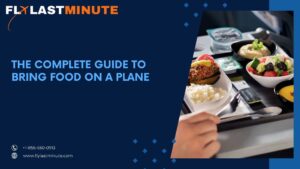
Traveling by plane can be an exciting experience, but it can also bring challenges, especially when it comes to bringing food. Whether you’re flying for business or leisure, having the right food with you can make your journey more enjoyable and convenient. However, navigating the rules and regulations surrounding food on planes can be tricky. This complete guide will walk you through everything you need to know about bringing food on a plane, ensuring that your trip is smooth and stress-free.
Understanding TSA and Airline Regulations
Before you start packing your snacks and meals, it’s crucial to understand the Transportation Security Administration (TSA) regulations. The TSA enforces strict rules regarding the transportation of food items to ensure safety and security. Here’s a breakdown of what you need to know:
- TSA Liquid Restrictions: The TSA’s 3-1-1 rule for liquids, gels, and aerosols applies to food items as well. Each container must be 3.4 ounces (100 milliliters) or less and fit into a single, quart-sized resealable bag. This rule applies to items such as soups, sauces, and yogurts. Solid foods are generally not subject to this restriction but must still pass through security screening.
- Solid Foods: Solid food items, including sandwiches, fruits, and snacks, are usually allowed in carry-on bags without restrictions. However, they must be screened by security, so be prepared to have your food items inspected. It’s also a good idea to pack solid foods in clear, resealable bags to expedite the screening process.
- Special Dietary Needs: If you have specific dietary needs or medical conditions that require special foods, you are allowed to bring these items through security. This includes baby formula, breast milk, and medically necessary liquids. Inform the TSA officer about these items, and they may require additional screening.
Packing Your Food for the Flight
Proper packing is key to ensuring your food remains fresh and undamaged during your flight. Here are some tips to help you pack your food effectively:
- Use Appropriate Containers: Opt for leak-proof containers to prevent spills and keep your food fresh. Airtight containers are also a good choice, especially for items like salads or sandwiches. If you’re bringing perishable items, consider using insulated bags or coolers to maintain their temperature.
- Pack Smart: When packing, place food items in easily accessible areas of your bag. This makes it easier to remove and inspect them during security screening. Additionally, use a separate bag or compartment for food to keep it organized and prevent it from being crushed by other items.
- Consider Security Screening: Remember that all food items must be screened by security. To avoid delays, keep your food separate from other items and inform the TSA officers if you have large quantities of food or special dietary items.
Navigating Customs Regulations
If you’re traveling internationally, customs regulations come into play. Different countries have varying rules regarding the importation of food, so it’s essential to research the specific regulations of your destination. Here’s what you need to know:
- Check Destination Rules: Some countries have strict regulations regarding the importation of certain food items, especially those that are perishable or made from animal products. Before traveling, check with the embassy or consulate of your destination country to ensure that your food items comply with their regulations.
- Declare Your Food Items: When arriving at your destination, you may be required to declare any food items you’re bringing with you. Failure to declare food items can result in fines or confiscation. Make sure to fill out any necessary customs forms accurately and honestly.
- Know What’s Allowed: Each country has a list of permitted and prohibited items. Familiarize yourself with these lists to avoid bringing restricted items into the country. Commonly restricted items include fresh fruits, vegetables, and meats.
Tips to Bring Food on a Plane
To ensure a smooth experience while bringing food on a plane, consider these additional tips:
- Opt for Non-Perishable Items: Non-perishable snacks like nuts, granola bars, and crackers are convenient and hassle-free. They don’t require refrigeration and are less likely to cause issues during security screening.
- Stay Hydrated: While you can bring water through security, it must be in containers of 3.4 ounces or less. Alternatively, purchase beverages after passing through security. Staying hydrated is essential, especially on long flights.
- Be Mindful of Smells: Avoid bringing strong-smelling foods that may disturb fellow passengers. Foods with strong odors can be unpleasant for those around you and may also attract attention during security checks.
- Consider the Flight Duration: For short flights, you might want to stick with simple snacks. For longer journeys, pack a more substantial meal or multiple snack options to keep yourself satisfied throughout the trip.
- Adhere to Airline Policies: While TSA regulations provide general guidelines, airlines may have their own policies regarding food. Check with your airline in advance to ensure you’re aware of any specific rules they may have.
Conclusion
Bring Food on a Plane doesn’t have to be a daunting task. By understanding TSA and customs regulations, packing wisely, and considering the specific needs of your journey, you can enjoy a more comfortable and enjoyable flight experience. Whether you’re traveling for business or leisure, having the right food can make a significant difference in your comfort and satisfaction. Follow these guidelines, and you’ll be well-prepared to navigate the challenges of air travel with ease. Safe travels and happy snacking!

